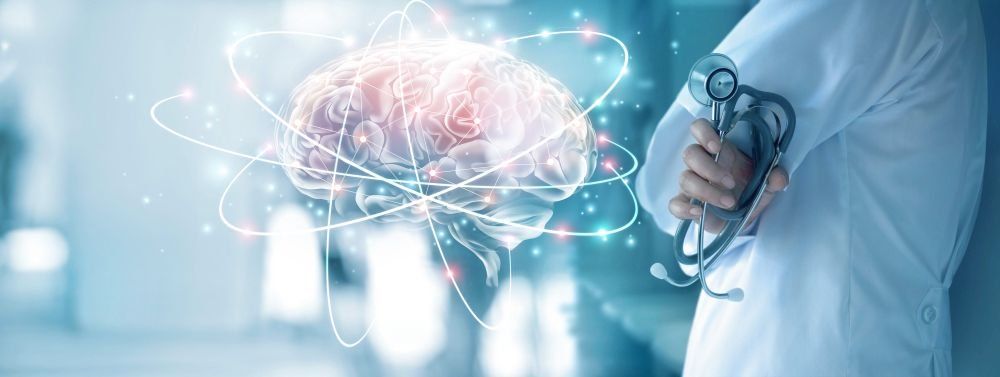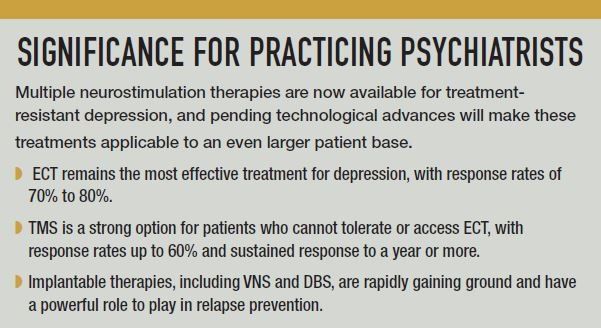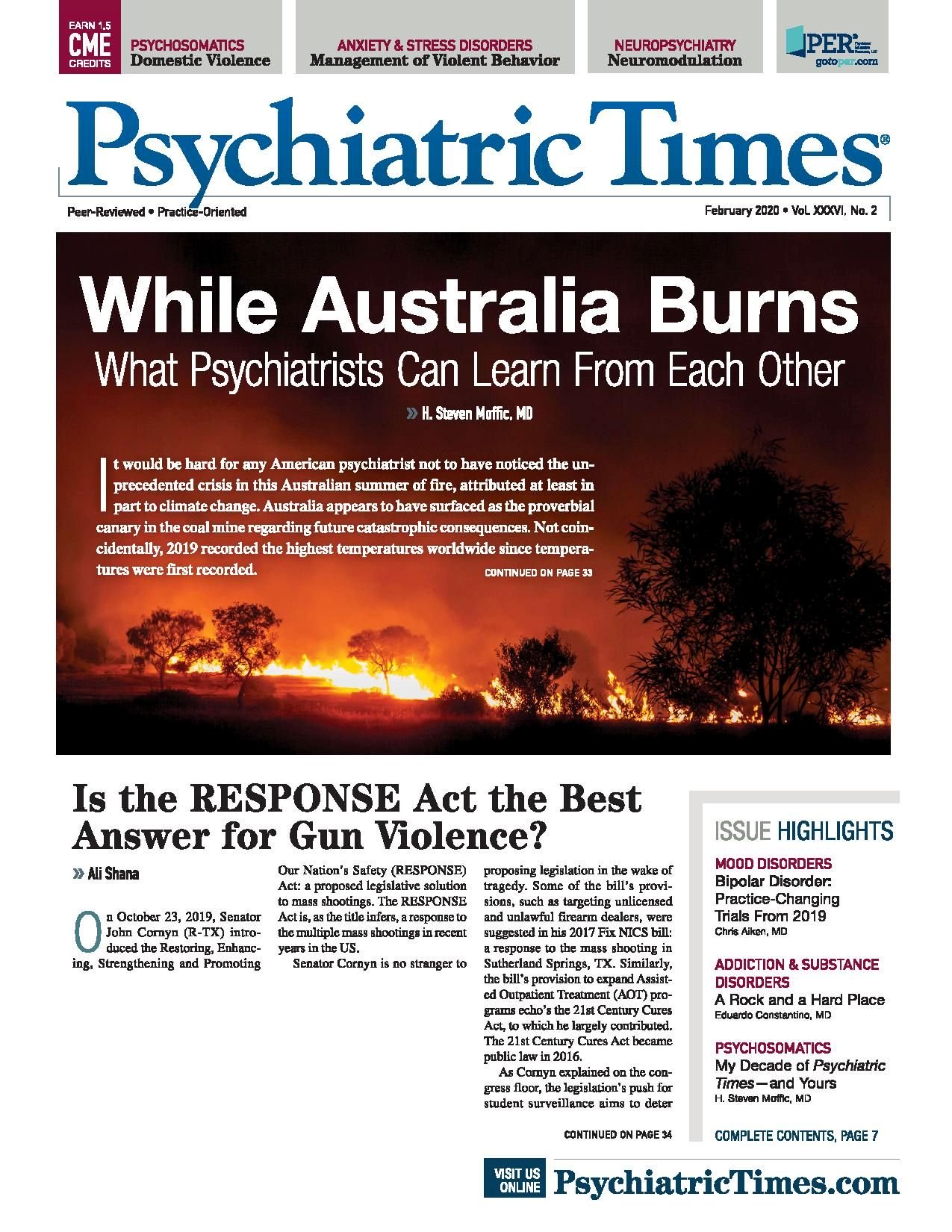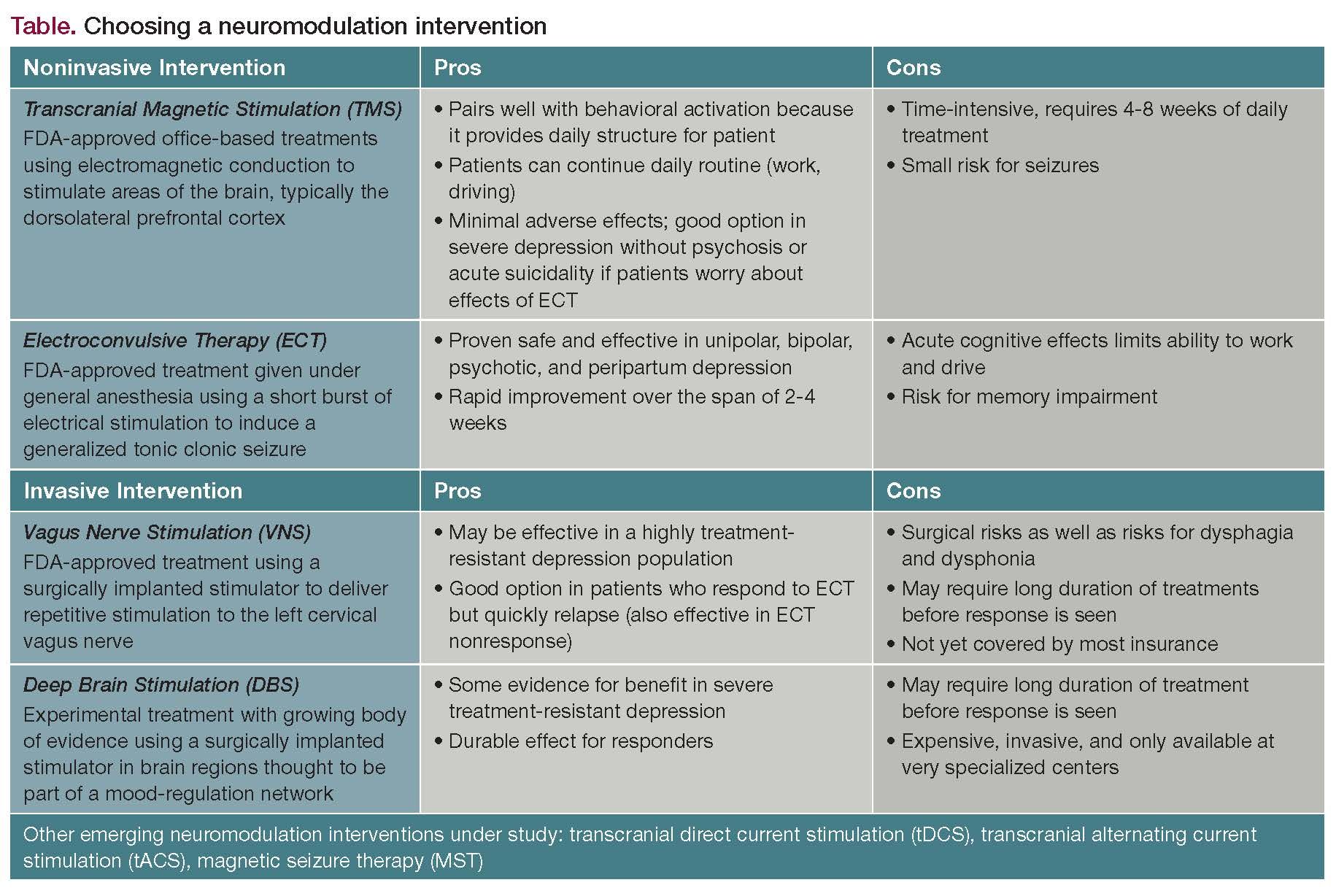Publication
Article
Psychiatric Times
Neuromodulation Approaches to Mood Disorders
Author(s):
As the evidence base grows and patients continue to demand better options, barriers will be lifted and neuromodulation will occupy a larger role in the psychiatric toolbox.

NEUROPSYCHIATRY
Since the first antidepressant in the 1950s, biological treatments for mood disorders have largely focused on altering monoaminergic neurotransmission, with only partial success. In the landmark STAR*D trial, 1 out of 3 patients did not achieve remission with a 4-tiered monoaminergic treatment algorithm. Neuromodulation therapies take an alternate approach: directly altering the brain’s electrical activity through electro-magnetic stimulation.
Selecting an intervention
Neuromodulation can be divided into invasive and non-invasive methods (Table). Both are mainly indicated for depressive symptoms, generally as an adjunct to pharmacotherapy and psychotherapy and usually in patients with treatment resistance. Treatment resistance means lack of response to 2 to 4 medications with adequate dose and duration. Usually, resistance includes lack of response to multiple medication classes and evidence-based psychotherapy.
Significance for the practicing psychiatrist

Related content: Mini Quiz: Deep Brain Stimulation for Depression
That said, neuromodulation is not a panacea. A careful examination of a patients’ psychosocial structure is necessary, as their mood is unlikely to show lasting change if severe, persistent stressors are present. Similarly, comorbid personality disorder may contribute to depressive symptoms or alter the response to neuromodulation.
Noninvasive neuromodulation
Electroconvulsive therapy (ECT). This hospital-based treatment uses an electrical current to induce a tonicclonic seizure under general anesthesia. An acute series consists of 3 weekly treatments for up to 4 weeks, with each session requiring at least an hour from pre-op to recovery.
ECT remains one of our most rapid and effective treatments for unipolar depression. Even with treatment resistance, response rates can exceed 70% to 80%. For those who respond but eventually have symptom relapse, maintenance ECT (weekly to monthly) is possible. ECT is safe and effective in bipolar, psychotic, and peripartum depression. In cases of depression with severe suicidal ideation, psychosis, or life-threatening catatonia, ECT should strongly be considered even in the absence of multiple medication trials.
While there are no absolute contraindications to ECT, increased intracranial pressure is a relative contraindication as treatment may exacerbate the condition. Cardiovascular disease also increases risk of treatment as the induced seizure causes a surge in blood pressure and heart rate. Patients’ primary concern, however, is the possibility of autobiographical memory loss. This is usually limited to memories from the treatment day, but patients (and some clinicians) still believe there is a risk of long-lasting cognitive impairment. Large studies and meta-analyses do not support these concerns. Moreover, cognitive risk is greatly reduced with modern techniques such as ultrabrief right unilateral ECT, which are just as effective as older approaches.
This highly effective treatment is often seen as a last resort, wasting months to years of patients’ lives on ineffective treatments. Discussing and delivering ECT earlier in the treatment algorithm would likely be beneficial. A challenge, however, is access. An acute ECT series is psychosocially disruptive, since patients usually are unable to work or to drive on treatment days. Hospitals find ECT difficult to justify financially, as it requires an anesthesiologist, additional support staff, and clinical space, all of which may be limited.
Focal electrically administered seizure therapy (FEAST) is a novel form of ECT that steers current away from the hippocampus, potentially reducing cognitive adverse effects. Pilot trials have been positive, and randomized trials should start in the next 1 to 2 years.1
Transcranial magnetic stimulation (TMS). An office-based treatment for unipolar depression, TMS also is often used off-label for bipolar depression. It is given daily (Monday through Friday) for 4 to 8 weeks with treatments usually lasting 20 to 30 minutes.
TMS uses a magnetic coil to induce electric currents in the prefrontal cortex (PFC). The size and shape of coils vary, and multiple parameters can be adjusted, including frequency (eg, excitatory: 10 Hz; inhibitory” 1 Hz), treatment duration, and target brain region. Some coils allow for deeper stimulation of cortical tissue (ie, deep TMS), but current literature does not show deep TMS to be superior to regular TMS when adjusting for placebo.
TMS does not cause cognitive impairment, so patients can continue driving and working. Depression response rates in naturalistic studies are good-30% to 60%.2 The effects appear durable, with one study showing 60% sustained response at 1 year.3 When there is symptom relapse, patients usually respond to another TMS series. Theta burst stimulation (TBS), a modified TMS that takes 10 minutes or less per treatment, may be as effective as longer sessions, potentially allowing treatment of many more patients with a single machine.
Although rare, seizure is the primary risk of TMS. The risk is higher with past seizures, brain injury, intracranial pathology, and substances/medications that reduce seizure threshold. TMS may still be usable in patients with increased risk, but with careful monitoring and dose titration. For example, we routinely adjust treatment energy based on changes in brain excitability (motor threshold), which correlates with seizure threshold. Regular dose adjustment also reduces headache, the most common adverse effect of TMS. Compared with ECT, TMS works more slowly, with response usually at 4 to 6 weeks into treatment.
TMS is less effective than ECT, but its safety and office-based nature promote continuous, rapid innovation. Controlling the context (and thus the brain state) under which TMS is given may improve outcomes. For instance, TMS could be delivered with cognitive training or psychotherapy that engages the circuit being stimulated, promoting beneficial brain plasticity. Treatment parameters might be tailored to a patient’s brain activity, ie, aspects of ongoing prefrontal rhythms. Response might be accelerated by delivering multiple TMS sessions within a single day.4 All of these require substantial further study and development but may improve outcomes. Finally, while there is minimal literature for the use of TMS in pregnancy, a small clinical trial recently showed safety and efficacy, an exciting prospect for an understudied population.5
Invasive neuromodulation
Vagus nerve stimulation (VNS). An implanted device that repeatedly stimulates the left cervical vagus nerve, VNS was FDA-approved in 2005 for adjunctive treatment of severe unipolar and bipolar depression. VNS leverages the vagus nerve’s afferent projections to brainstem nuclei. Moreover, it may augment norepinephrine and dopamine signaling throughout the brain through those projections, in turn enhancing the effects of monoaminergic medication. The implant procedure takes approximately 2 hours and can be completed under local or general anesthesia. Patients return for office-based stimulator programming by a trained clinician. Programming is typically repeated biweekly to monthly over the first 6 months of treatment. VNS is usually reserved for patients who have not responded to medications or to noninvasive forms of neuromodulation.
Although FDA-approved, VNS is rarely covered by commercial insurance because of its limited evidence base. The published large randomized, controlled trial failed to show separation between active and sham stimulation after 10 weeks.6
However, study design had a short comparison period. FDA approval was based on data from a one-year open-label follow-up that showed increasing response rates with time. A 5-year open-label study of 795 patients replicated this result, with significantly higher VNS response rates compared with treatment as usual (67.6% vs 40.9%).7 This study has brightened VNS’ prospects-Medicare will soon cover VNS as part of a large observational study, and commercial insurers are slowly following.
VNS offers long-term benefit even for treatment-resistant depression. A subanalysis in the 5-year study showed significantly higher response rate to VNS compared with treatment as usual (59.6% vs 34.1%). The response rate was even higher in patients who previously responded to ECT (71.3% vs 56.9%). In addition, patients who remitted remained in remission longer with VNS compared to treatment as usual (40 months versus 19 months), although this did not reach statistical significance.
As with any surgical procedure, VNS carries a risk for pain and infection. The vagus nerve innervates muscles involved in swallowing and speech, and surgical damage can result in dysphagia or vocal cord paralysis. The risk of these complications is less than 1% with a well-trained surgeon. The stimulation frequently switches on and off, and many patients note throat sensations or voice changes, both of which remit over time.
The primary limitations of VNS are logistical. Because the effects take months to be noticeable, patients may prefer a more rapid-acting treatment. Most payors still do not cover VNS, limiting patients’ access.
A large multisite, randomized, double-blind controlled study is about to start, which should clarify the efficacy of VNS. Non-invasive VNS devices may greatly expand its reach while reducing costs. A transcutaneous stimulation device (tVNS) was FDA-cleared in 2018 for treatment of migraines and cluster headaches. Similar systems may be very useful for mood disorders.
Deep Brain Stimulation (DBS). An experimental treatment for unipolar and bipolar depression, DBS involves MRI-assisted electrode implantation directly into brain regions associated with mood. The procedure takes 3 to 6 hours and is done under a combination of local and general anesthesia. Multiple brain targets have been tested in clinical trials, all with similar effects, which suggests that they may all be nodes in a common “mood regulation” network.8 DBS has only been tested in patients who no longer respond to any other therapy.
Initially, DBS patients report “disappearance of the void,” reduced anxiety, increased connectedness, and euphoria, subjective changes that usually fade within minutes to hours. Continued stimulation over weeks to months leads to more gradual improvement. In early open label studies, response rates were 40% to 66% in severely treatment-refractory cases.9,10 The evidence from randomized, well-controlled studies is less clear. Two US industry-funded trials, where all patients received implants but only some of the implants were activated, failed to show a separation between DBS and sham stimulation.11,12 European trials that used a different design, however, showed a separation.13 DBS may require long durations to demonstrate its effect. When it is effective, the benefits appear to last-a recent study reported over 50% response rate at 8 years post-DBS.14
Risks include intracranial bleeding, stroke, seizure, and infection, but all are very rare (less than 1%). Adverse psychological effects are more common-up to 50% of patients may experience worsened mood, anxiety, or hypomania while their clinicians search for optimal stimulation settings. Furthermore, patients often see DBS as a last resort. If response is delayed or difficult to achieve, they can lose hope. This is life-threatening, as evidenced by a suicide rate close to 10% in DBS clinical trials.
The largest challenge of DBS is the wide range of stimulation parameters that can be applied, with no clear guidance on how to search for the best settings. Neuroimaging research seeks to better define the target mood circuit, and to use advanced electric field modeling to optimally activate the desired neural pathways. Closed loop approaches seek to sense brain activity in real time and allow the device to self-adjust until a desired activity pattern is achieved. Either strategy may lead to higher and more durable clinical response rates.
Emerging neuromodulation
While ECT, TMS, VNS, and DBS represent some of our best-studied tools for mood disorders, the landscape of neuromodulation is rapidly changing, and several emerging interventions are actively being studied. These encompass a variety of techniques including direct electrical stimulation at sub-threshold energy levels with transcranial direct current stimulation (tDCS) or transcranial alternating current stimulation (tACS) as well as other forms of seizure therapy such as magnetic seizure therapy (MST). Further evidence is needed to support their clinical use at this time.
Accessing neuromodulation
While neuromodulation services are limited in community practice, most academic institutions now employ at least one neuromodulation specialist. Referral to such specialists is often the first step in helping patients access these next-generation treatments. A critical aspect of referral is a detailed treatment history, especially medications tried and reasons for nonresponse. That history often influences treatment selection and is critical for obtaining payor approval. Lack of reimbursement remains the single largest barrier to offering patients these circuit-based treatments. As the evidence base grows and patients continue to demand better options, this barrier will fall, and neuromodulation will occupy a larger role in the psychiatric toolbox.
Disclosures:
Dr Wang is Psychiatry Resident, and Dr Widge is Assistant Professor, Department of Psychiatry and Behavioral Sciences, University of Minnesota, Minneapolis, MN. Dr Wang reports no conflicts of interest concerning the subject matter of this article; Dr Widge reports patent applications in the area of deep brain stimulation that are not licensed to any entity.
References:
1. Sahlem GL, Short EB, Kerns S, et al. Expanded safety and efficacy data for a new method of performing electroconvulsive therapy. J ECT. 2016;32:197-203.
2. Taylor SF, Bhati MT, Dubin MJ, et al. A naturalistic, multi-site study of repetitive transcranial magnetic stimulation therapy for depression. J Affect Disord. 2017;208:284-290.
3. Dunner DL, Aaronson ST, Sackeim HA, et al. A multisite, naturalistic, observational study of transcranial magnetic stimulation for patients with pharmacoresistant major depressive disorder: durability of benefit over a 1-year follow-up period. J Clin Psychiatry. 2014;75:1394-1401.
4. Duprat R, Desmyter S, Rudi DR, et al. Accelerated intermittent theta burst stimulation treatment in medication-resistant major depression: a fast road to remission? J Affect Disord. 2016;200:6-14.
5. Kim DR, Wang E, McGeehan B, et al. Randomized controlled trial of transcranial magnetic stimulation in pregnant women with major depressive disorder. Brain Stim. 2019;12:96-102.
6. Rush AJ, Marangell LB, Sackeim HA, et al. Vagus nerve stimulation for treatment-resistant depression: a randomized, controlled acute phase trial. Biol Psychiatry. 2005;58:347-354.
7. Aaronson ST, Sears P, Ruvuna F, et al. A 5-year observational study of patients with treatment-resistant depression treated with vagus nerve stimulation or treatment as usual: comparison of response, remission, and suicidality. Am J Psychiatry. 2017;174:640-648.
8. Widge AS, Malone DAJ, Dougherty DD. Closing the loop on deep brain stimulation for treatment-resistant depression. Front Neurosci. 2018;12:175.
9. Mayberg HS, Lozano AM, Voon V, et al. Deep brain stimulation for treatment-resistant depression. Neuron. 2005;45:651-660.
10. Malone DA, Dougherty DD, Rezai AR, et al. Deep brain stimulation of the ventral capsule/ ventral striatum for treatment-resistant depression. Biol Psychiatry. 2009;65:267-275.
11. Holtzheimer PE, Husain MM, Lisanby SH, et al. Subcallosal cingulate deep brain stimulation for treatment-resistant depression: a multisite, randomised, sham-controlled trial. Lancet Psychiatry. 2017;4:839-849.
12. Dougherty DD, Rezai AR, Carpenter LL, et al. A randomized sham-controlled trial of deep brain stimulation of the ventral capsule/ventral striatum for chronic treatment-resistant depression. Biol Psychiatry. 2015;78:240248.
13. Bergfeld IO, Mantione M, Hoogendorn et al. Deep brain stimulation of the ventral anterior limb of the internal capsule for treatment-resistant depression: a randomized clinical trial. JAMA Psychiatry. 2016;73:456-464.
14. Crowell AL, Riva-Posse P, Holtzheimer PE, et al. Long-term outcomes of subcallosal cingulate deep brain stimulation for treatment-resistant depression. Am J Psychiatry. 2019;176:949-952.








